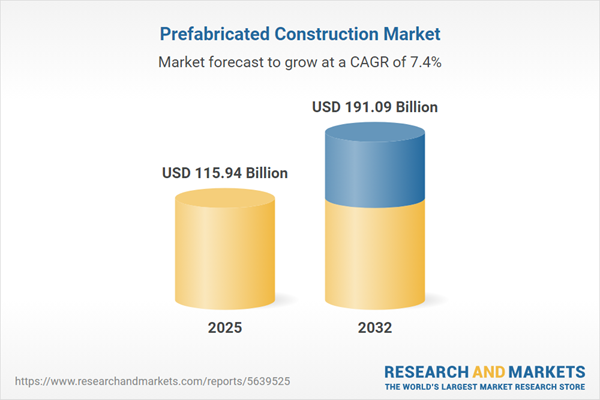Speak directly to the analyst to clarify any post sales queries you may have.
Senior leaders in construction are increasingly adopting prefabricated construction methods to achieve greater efficiency, improve project outcomes, and confidently navigate industry change. This strategic adoption supports organizational adaptability, operational resilience, and enhanced collaboration across all phases of the construction journey.
Market Snapshot: Prefabricated Construction Market Growth Trajectory
The prefabricated construction market is on an upward trajectory, reflecting strong momentum in modular building and integrated management systems. In 2024, the sector reached a market value of USD 107.84 billion and is projected to grow to USD 115.94 billion by 2025. Backed by a 7.41% compound annual growth rate, the industry's value is expected to reach USD 191.09 billion by 2032. This growth is fueled by greater investment in adaptable design strategies, regulatory alignment, and sophisticated project management technologies. Enhanced quality assurance and predictable schedules are positioning prefabrication as a preferred choice in both commercial and residential developments, leading to expanded opportunities for enterprises seeking competitive advantage.
Scope & Segmentation: Comprehensive Prefabricated Construction Market Landscape
- Product Types: Modular construction solutions are tailored for specific project objectives. Panelized systems enable faster assembly through off-site fabrication. Precast beams and slabs ensure reliability and adherence to demanding standards. Turnkey volumetric modules minimize labor requirements at the construction site and speed up overall project delivery.
- End Uses: Prefabricated solutions are implemented across a diverse range of applications including offices, hospitality venues, logistics hubs, retail spaces, and residential buildings to drive scalability and optimize construction outcomes.
- Construction Types: Permanent structures address long-term infrastructure needs, while relocatable, temporary models offer adaptability for projects with variable timelines or shifting requirements.
- Materials: Concrete delivers durable, long-lasting performance; steel supports intricate and larger-scale engineering; engineered wood advances environmental goals and assists with compliance needs.
- Delivery Modes: Off-site manufacturing reduces on-site disruption and accelerates project timelines, helping to mitigate risks associated with local sourcing or delays.
- Regional Coverage: The United States, Canada, and Europe represent mature markets for prefabricated construction. Rapid growth is noted in the Asia-Pacific region, fueled by urban expansion, while the Middle East, Africa, and Latin America add diversity and new avenues for sector development.
- Technologies: Building Information Modeling (BIM), automation, digital twin technology, and cloud-based life-cycle solutions play a central role by improving process transparency, integrating data, and enabling consistent management from planning through completion.
- Featured Companies: Leading players include Broad Group Co., Ltd, Sekisui House, Ltd, Larsen & Toubro Limited, Skanska AB, Laing O’Rourke Limited, Balfour Beatty plc, Algeco Scotsman Holdings Limited, Clayton Homes, LLC, Red Sea Housing Services Co., Ltd, and Prescient, Inc., each contributing to industry expertise and international standards.
Key Takeaways for Senior Decision-Makers
- Prefabrication enables rapid response to changing regulatory requirements and evolving project demands, fostering organizational resilience.
- Adopting advanced digital platforms and Internet of Things (IoT) technology optimizes coordination and supports informed decision-making across each stage of the build process.
- Utilizing certified and sustainable materials not only supports environmental goals but also maintains compliance with emerging standards.
- Modular and off-site methods provide the flexibility to scale operations and pursue new opportunities across geographies with reduced setup time.
- Strengthening collaboration with supply partners and refining logistics networks helps control production variability, minimize delays, and maintain reliable cost structures.
- Leadership can leverage real-time project insights to enhance visibility, manage risk proactively, and drive performance across diversified construction portfolios.
Tariff Impact: Navigating Trade Regulation in the U.S.
Frequent shifts in trade policy and tariffs on critical construction materials have prompted U.S. firms to diversify engineering and procurement approaches. Digital procurement tools and refined supply chain management are pivotal in controlling costs, ensuring delivery schedules, and addressing regulatory fluctuations.
Methodology & Data Sources
This analysis is built on executive-level interviews, exclusive industry research, and advanced quantitative modeling. All data are validated by subject matter experts and academic reviewers to guarantee relevance and strategic value for stakeholders in prefabricated construction.
Why This Report Matters: Empowering Strategic Decision-Making
- Delivers actionable insights for digital transformation initiatives and comprehensive asset management across all build stages.
- Provides guidance to navigate compliance challenges and mitigate risks, supporting informed investment planning for construction leaders.
- Enables integration and consistency of workflows, driving agility for multi-site and multi-regional project execution.
Conclusion
Prefabricated construction supports sustainable leadership and strategic flexibility for industry organizations. By prioritizing technology integration and streamlined supply chains, companies are well-positioned to advance their objectives and overcome future project challenges.
Additional Product Information:
- Purchase of this report includes 1 year online access with quarterly updates.
- This report can be updated on request. Please contact our Customer Experience team using the Ask a Question widget on our website.
Table of Contents
3. Executive Summary
4. Market Overview
7. Cumulative Impact of Artificial Intelligence 2025
Companies Mentioned
The companies profiled in this Prefabricated Construction market report include:- Broad Group Co., Ltd.
- Sekisui House, Ltd.
- Larsen & Toubro Limited
- Skanska AB
- Laing O'Rourke Limited
- Balfour Beatty PLC
- Algeco Scotsman Holdings Limited
- Clayton Homes, LLC
- Red Sea Housing Services Co., Ltd.
- Prescient, Inc.
Table Information
| Report Attribute | Details |
|---|---|
| No. of Pages | 192 |
| Published | November 2025 |
| Forecast Period | 2025 - 2032 |
| Estimated Market Value ( USD | $ 115.94 Billion |
| Forecasted Market Value ( USD | $ 191.09 Billion |
| Compound Annual Growth Rate | 7.4% |
| Regions Covered | Global |
| No. of Companies Mentioned | 11 |









